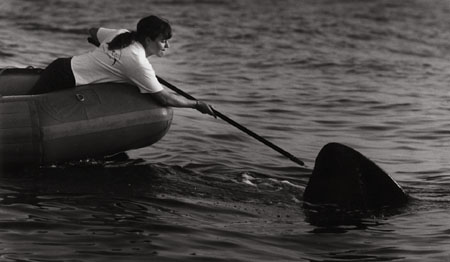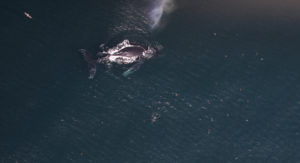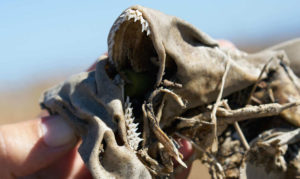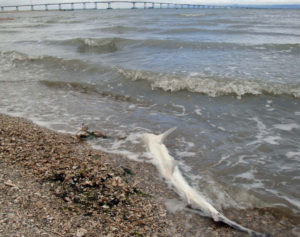Some unwitting humans are bobbing in the water off the coast of California. A gigantic shark, 30 feet long, rises from the depths of the dark ocean. The shark slowly approaches the people, and then … drifts by with mouth agape, enjoying its lunch of plankton.
Consider yourself introduced to the basking shark, the world’s second-largest shark.
We don’t know much about basking sharks except that they have been systematically hunted and inadvertently killed to a point near extinction, and they’re now getting some attention from local scientists, governments, and fishermen.
Sean van Sommeran of the Pelagic Shark Research Foundation in Santa Cruz will do the tagging for researchers at Stanford, including Steven G. Wilson of the Hopkins Marine Station. Wilson led the effort to secure a grant in collaboration with the National Oceanic and Atmospheric Administration to tag and follow three basking sharks with state-of-the-art satellite tags off the coast of California.
Researchers have long been tagging sharks with low-tech, brightly colored ID tags. These “spaghetti tags” look like bits of neon seaweed stuck on the sharks’ backs.
The new satellite tags are similarly attached, but they have significant computer equipment encased in resin. These three tags, which cost up to $5,000 apiece, will be some of the first using this kind of technology applied to basking sharks on the West Coast.
I asked van Sommeran if something must be driven through the shark’s fin to secure the tag. “No,” says van Sommeran, “a basking shark fin is as thick as a door.” Better, it turns out, is inserting a barbed pin–a surgical harpoon–into the shark’s flesh near base of the dorsal fin. “You need to get it right at mid-ship, in the stable part of the animal, and out of its way,” explains Van Sommeran, who has been tagging sharks since 1988. “The dart fastens right in the hide. These animals make great platforms for this type of research. Like most sharks, they are resistant to infections, and the wound heals right up without problems.”
The satellite tags have internal computers that will take measurements of pressure, light, depth, and global position, archive the information, and after 350 days, eject from the shark and float to the surface. There, they will transmit the data via satellite to the researchers’ computers.
The North Pacific population of basking sharks has been in sharp decline. Van Sommeran first saw a basking shark when he was 15 years old. “Basking sharks were once so abundant they were considered a nuisance, a hazard to navigation,” he says. “I haven’t laid eyes on one since 2002.”
According to the IUCN Red List, the international authority on conservation status, the basking shark is “vulnerable” worldwide. Worse, the North Pacific stock is marked “endangered.”
Basking sharks have few marine predators, including the orca, but their primary threat comes from humans. Basking sharks get their name from their habit of feeding on zooplankton close to the ocean’s surface. They appear to bask as they sieve food through their gills, but this habit makes them easy targets for fishing.
- Pelagic Shark Research Foundation staffer Susan Arnold leans out from a small boat to tag a basking shark in 1993. Basking sharks will be tagged in a similar way. Photo courtesy Pelagic Shark Research Foundation.
The shark’s large, oily liver helps the fish float. It can account for one quarter of total body weight and is the exact reason the sharks have been so desirable to world markets. Shark-liver oil, or “squalene,” has been used as a nutritional supplement, lamp fuel, industrial lubricant, and folk remedy. Hakarl, an obscure Icelandic delicacy made from sticking a shark in the sand and letting it ferment, is often made from basking sharks. Here in Monterey Bay, the sharks were killed for their hides, meat, and fins.
Van Sommeran and his team are waiting for a reported sighting of a basking shark, and he says Monterey Bay is a hot spot for finding one. “A half-hour out of the dock, you have a mile of water under the boat. Besides,” he says, “there’s a network of fishing and whale-watching boats that will help spot one.” If they don’t turn up the hoped-for shark by this fall, his team will range as far as San Diego using aircraft for spotting.
But the researchers must be selective in their tagging. With only three tags, accuracy at the moment of tagging is key. And for such high-tech tags, the most important act is decidedly one of practice, and some luck: The researchers fasten the tags using a long pole as they lean out from a small skiff in open water. “You have to go out at first light,” says van Sommeran. “The wind picks up sometime between 11 and 2, the waves swell, and there are white caps. You don’t want to be doing this in a bouncy boat.”
Van Sommeran hopes this research will help basking sharks. “So far, our only data we have for them is when we’re killing them,” he says. And that happens only at the surface. He’s curious where the sharks spend most of their time, how fast, and how far they travel.
“This is a perfect opportunity to know them better,” van Sommeran said. “Perhaps some day we will be able to reflect back on the history and be glad we didn’t lose them.”
Learn more about the Hopkins Marine Lab at www-marine.stanford.edu, and more about Sean van Sommeran’s work at pelagic.org.

.jpg)




